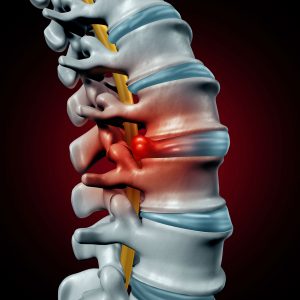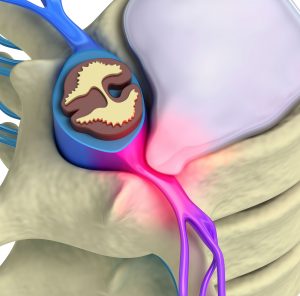If you have a herniated disc, you’re not alone. In a study published in 2018, 5 to 20 per 1,000 adult cases of disc herniation occur each year. It’s one of the most common causes of lower back and leg pain in most people.

Depending on the severity of the herniation, it can be treated and realigned; however, even after realignment, most people are at risk of the disc slipping again. It’s important to investigate your treatment options and dedicate yourself to your treatment plan to help avoid re-injury and promote a faster healing process.
What is a disc herniation?
The vertebrae in the spine are separated from one another by a jelly-like substance called a disc. This disc keeps the vertebrae from rubbing against each other, causing compression of the nerves, bone spurs, and arthritis. They also absorb a lot of the shock and trauma the human body experiences in physical activities.
A herniated disc, also called a “ruptured” or “slipped” disc, occurs when that jelly-like substance is pushed or forced out from between the two vertebrae, usually as a result of a trauma or degenerative changes in the vertebrae. This slipping essentially removes the safety net from the network of nerves that runs through the spine. This allows the two vertebrae to rub against each other, pinching nerves and causing pain and numbness in affected areas of the body. Sometimes the disc itself puts pressure on the nerves.
Causes of disc herniation
Disc herniation can happen in several ways. A simple strain or injury can be the cause in some cases, but in others, degenerative changes are typically to blame. These include degenerative disc disease, scoliosis, spinal stenosis, obesity, genetics, and poor posture.
Symptoms of disc herniation
The most common symptom of a disc herniation is pain. Herniated disc pain can be localized to the compressed area of the spine, or it can radiate out to the extremities if the nerves to those extremities are being pinched.
In severe nerve entrapment or compression, the pain can rise to a burning or electrical shock sensation. Other symptoms include pins and needles sensations, tingling, numbness, or weakness.

A herniated disc in your neck, or cervical herniation, pain can radiate into the shoulders, arms, hands and fingers. Herniation in the middle of the back, also called a thoracic herniation, can cause pain in the abdomen, or radiate to other sections of the back. A lumbar herniation, or lower back herniation, can radiate into the buttocks, hips, thighs, calves, ankles, feet, and toes.
All these symptoms can be extremely debilitating and interrupt normal, everyday activities. If left alone, the pain will sometimes resolve on its own, but that does not mean the herniation is fixed.
Diagnosis of a herniated disc
Herniated discs are typically diagnosed through x-ray or MRI imaging, coupled with physical assessments. Your doctor or chiropractor may ask you to try to move in certain directions or lift your legs and arms to test your flexibility and assess which disc may be involved in the herniation. Imaging will usually confirm the herniation area.
Treatments for herniated discs
One of the most common treatments for herniated discs is surgery. There are 4 major forms of spinal surgery used for treating herniated discs: spinal fusion, discectomy, laminectomy, or artificial disc insertion.
While spinal surgery has come a long way in recent years, these surgeries still carry significant risks, including worsening of symptoms, loss of mobility, and even partial paralysis.
Many people choose instead to explore non-invasive treatment options such as chiropractic care, physical therapy, massage therapy, and other treatments.
A chiropractor is well-versed in the health and anatomy of the spine and the potential impact a compressed nerve in the spine can have on other areas of the body. Through gentle spinal manipulation techniques, a chiropractor can restore your original spinal alignment.
Supporting your chiropractic care with physical therapy and an exercise regimen will increase your chances of long-term success and decrease your risk of re-rupturing your disc. Targeted stretches and exercises can strengthen the muscles around the spine to help support it and keep it in its proper alignment.
Chiropractors also use pain management therapies, including cold laser therapy and electric muscle stimulation which reduce inflammation and swelling of the muscles and promote increased blood flow to the damaged nerves and muscle tissue.
Massage therapy is another excellent treatment option for disc herniation, as it relaxes muscles in the injured area and promotes blood flow to stimulate healing and regeneration of the tissue.

